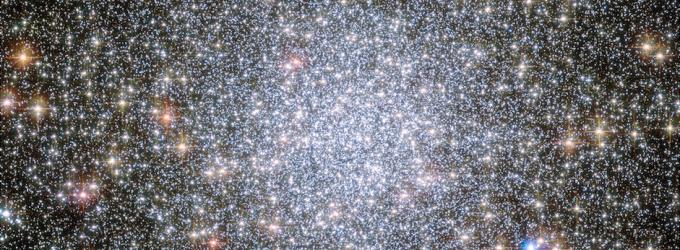
 Globular star clusters are extraordinary in almost every way. They’re densely packed, holding a million stars in a ball only about 100 light-years across on average. They’re old, dating back almost to the birth of the Milky Way. And according to new research, they also could be extraordinarily good places to look for space-faring civilizations.
Globular star clusters are extraordinary in almost every way. They’re densely packed, holding a million stars in a ball only about 100 light-years across on average. They’re old, dating back almost to the birth of the Milky Way. And according to new research, they also could be extraordinarily good places to look for space-faring civilizations.
“A globular cluster might be the first place in which intelligent life is identified in our galaxy,” says lead author Rosanne Di Stefano of the Harvard-Smithsonian Center for Astrophysics (CfA).
Our Milky Way galaxy hosts about 150 globular clusters, most of them orbiting in the galactic outskirts. They formed about 10 billion years ago on average. As a result, their stars contain fewer of the heavy elements needed to construct planets, since those elements (like iron and silicon) must be created in earlier generations of stars. Some scientists have argued that this makes globular cluster stars less likely to host planets. In fact, only one planet has been found in a globular cluster to date.
However, Di Stefano and her colleague Alak Ray (Tata Institute of Fundamental Research, Mumbai) argue that this view is too pessimistic. Exoplanets have been found around stars only one-tenth as metal-rich as our Sun.
“It’s premature to say there are no planets in globular clusters,” states Ray.
Another concern is that a globular cluster’s crowded environment would threaten any planets that do form. A neighboring star could wander too close and gravitationally disrupt a planetary system, flinging worlds into icy interstellar space.
However, a star’s habitable zone—the distance at which a planet would be warm enough for liquid water—varies depending on the star. While brighter stars have more distant habitable zones, planets orbiting dimmer stars would have to huddle much closer. Brighter stars also live shorter lives, and since globular clusters are old, those stars have died out. The predominant stars in globular clusters are faint, long-lived red dwarfs. Any potentially habitable planets they host would orbit nearby and be relatively safe from stellar interactions.
“Once planets form, they can survive for long periods of time, even longer than the current age of the universe,” explains Di Stefano.
So if habitable planets can form in globular clusters and survive for billions of years, what are the consequences for life should it evolve? Life would have ample time to become increasingly complex, and even potentially develop intelligence.
Such a civilization would enjoy a very different environment than our own. The nearest star to our solar system is four light-years, or 24 trillion miles, away. In contrast, the nearest star within a globular cluster could be about 20 times closer—just one trillion miles away. This would make interstellar communication and exploration significantly easier.
“We call it the ‘globular cluster opportunity,’” says Di Stefano. “Sending a broadcast between the stars wouldn’t take any longer than a letter from the U.S. to Europe in the 18th century.”
“Interstellar travel would take less time too. The Voyager probes are 100 billion miles from Earth, or one-tenth as far as it would take to reach the closest star if we lived in a globular cluster. That means sending an interstellar probe is something a civilization at our technological level could do in a globular cluster,” she adds.


Be the first to comment